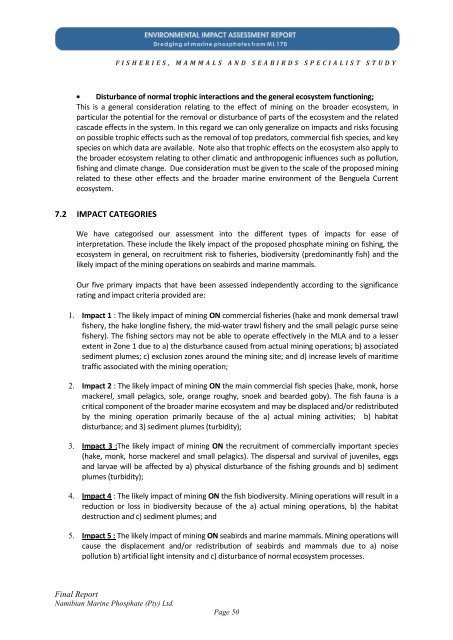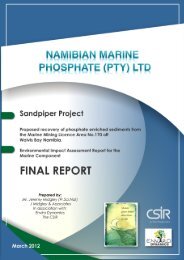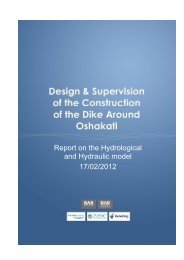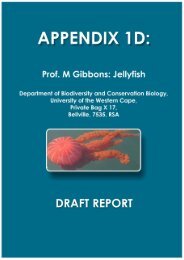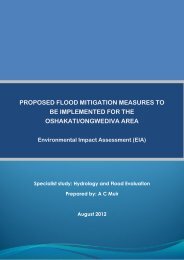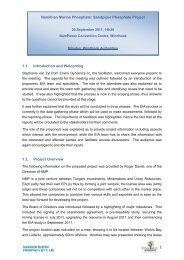Fisheries - Enviro Dynamics Namibia
Fisheries - Enviro Dynamics Namibia
Fisheries - Enviro Dynamics Namibia
Create successful ePaper yourself
Turn your PDF publications into a flip-book with our unique Google optimized e-Paper software.
F I S H E R I E S , M A M M A L S A N D S E A B I R D S S P E C I A L I S T S T U D Y<br />
Disturbance of normal trophic interactions and the general ecosystem functioning;<br />
This is a general consideration relating to the effect of mining on the broader ecosystem, in<br />
particular the potential for the removal or disturbance of parts of the ecosystem and the related<br />
cascade effects in the system. In this regard we can only generalize on impacts and risks focusing<br />
on possible trophic effects such as the removal of top predators, commercial fish species, and key<br />
species on which data are available. Note also that trophic effects on the ecosystem also apply to<br />
the broader ecosystem relating to other climatic and anthropogenic influences such as pollution,<br />
fishing and climate change. Due consideration must be given to the scale of the proposed mining<br />
related to these other effects and the broader marine environment of the Benguela Current<br />
ecosystem.<br />
7.2 IMPACT CATEGORIES<br />
We have categorised our assessment into the different types of impacts for ease of<br />
interpretation. These include the likely impact of the proposed phosphate mining on fishing, the<br />
ecosystem in general, on recruitment risk to fisheries, biodiversity (predominantly fish) and the<br />
likely impact of the mining operations on seabirds and marine mammals.<br />
Our five primary impacts that have been assessed independently according to the significance<br />
rating and impact criteria provided are:<br />
1. Impact 1 : The likely impact of mining ON commercial fisheries (hake and monk demersal trawl<br />
fishery, the hake longline fishery, the mid-water trawl fishery and the small pelagic purse seine<br />
fishery). The fishing sectors may not be able to operate effectively in the MLA and to a lesser<br />
extent in Zone 1 due to a) the disturbance caused from actual mining operations; b) associated<br />
sediment plumes; c) exclusion zones around the mining site; and d) increase levels of maritime<br />
traffic associated with the mining operation;<br />
2. Impact 2 : The likely impact of mining ON the main commercial fish species (hake, monk, horse<br />
mackerel, small pelagics, sole, orange roughy, snoek and bearded goby). The fish fauna is a<br />
critical component of the broader marine ecosystem and may be displaced and/or redistributed<br />
by the mining operation primarily because of the a) actual mining activities; b) habitat<br />
disturbance; and 3) sediment plumes (turbidity);<br />
3. Impact 3 :The likely impact of mining ON the recruitment of commercially important species<br />
(hake, monk, horse mackerel and small pelagics). The dispersal and survival of juveniles, eggs<br />
and larvae will be affected by a) physical disturbance of the fishing grounds and b) sediment<br />
plumes (turbidity);<br />
4. Impact 4 : The likely impact of mining ON the fish biodiversity. Mining operations will result in a<br />
reduction or loss in biodiversity because of the a) actual mining operations, b) the habitat<br />
destruction and c) sediment plumes; and<br />
5. Impact 5 : The likely impact of mining ON seabirds and marine mammals. Mining operations will<br />
cause the displacement and/or redistribution of seabirds and mammals due to a) noise<br />
pollution b) artificial light intensity and c) disturbance of normal ecosystem processes.<br />
Final Report<br />
<strong>Namibia</strong>n Marine Phosphate (Pty) Ltd.<br />
Page 50


